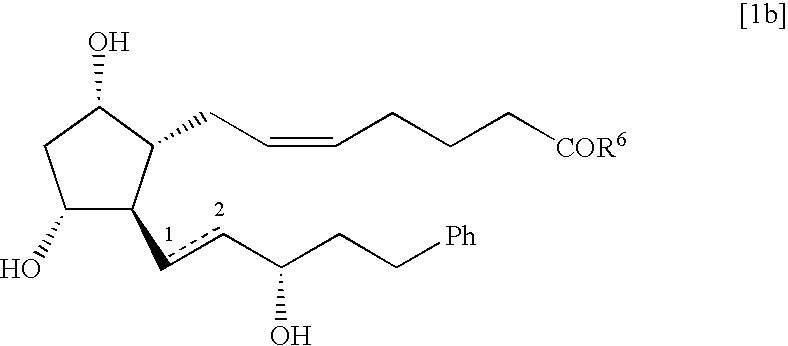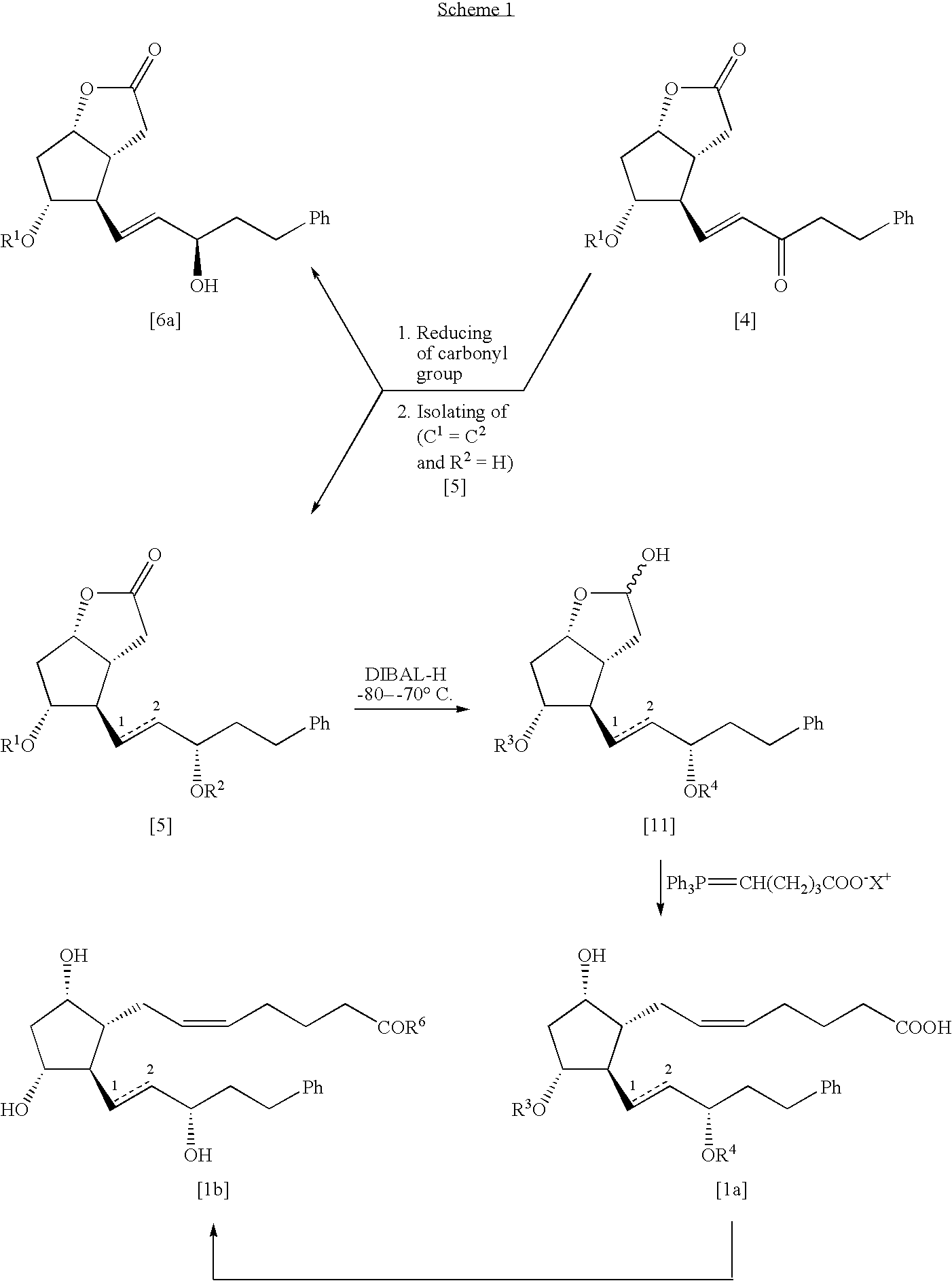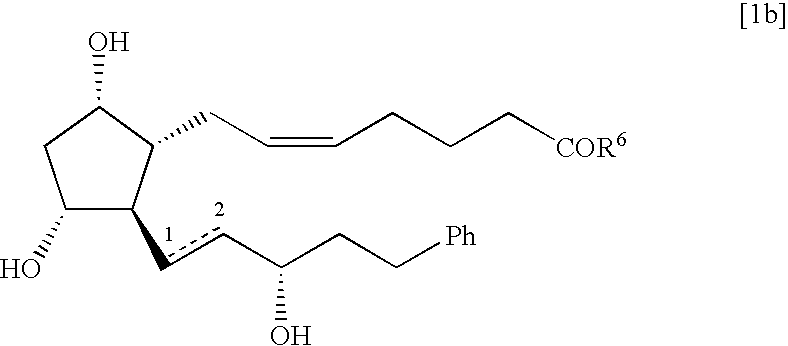Process for the preparation of 17-phenyl-18,19,20-thinor-pgf 2a and its derivatives
a technology of pgf2a and pgf2, which is applied in the preparation of carboxylic compounds, organic chemistry, chemistry apparatus and processes, etc., can solve the problems of difficult separation, increased the likelihood of optic nerve damage and visual field loss, and the loss of iop, so as to achieve good yield and large amounts , the effect of desired purity
- Summary
- Abstract
- Description
- Claims
- Application Information
AI Technical Summary
Benefits of technology
Problems solved by technology
Method used
Image
Examples
example 1
(3aR,4R,5R,6aS)-Hexahydro-4-(3-oxo-5-phenyl-1E-pentenyl)-5-(p-phenylbenzoyl oxy)-2H-cyclopenta[b]furan-2-one [4a]
[0047]
1) Preparation of dimethyl (2-oxo-4-phenylbutyl)phosphonate
1.1) 1-Bromo-4-phenyl-2-butanone
[0048]A freshly prepared solution of bromine (258.9 g) in methanol (600 mL) was added dropwise during 1 h 20 min to a stirred solution of benzylacetone (222.3 g) in methanol (600 mL) at 7–10° C. An exothermic reaction took place, and to maintain the necessary temperature (7–10° C.), the flask should be immersed in a ice-water bath. When orange-red color of bromine disappeared, water (1500 mL) was added to the mixture and the obtained mixture was stirred overnight. The organic layer (on the bottom) was separated, water phase was extracted with dichloromethane (2×600 mL). The combined organic layers were dried over sodium sulfate, filtered and evaporated under reduced pressure. The oily residue was dissolved in hexane (2500 mL) and the obtained solution was kept overnight at −10...
example 2
(3aR,4R,5R,6aS)-Hexahydro-5-(p-phenylbenzoyloxy)-4-[(3S)-5-phenyl-3-[(tetrahydro-2H-pyran-2-yl)oxy]-1E-pentenyl]-2H-cyclopenta[b]furan-2-one [5] (C1═C2, R1=PPB and R2=THP)
[0053]
1) Preparation of (3aR,4R,5R,6aS)-hexahydro-4-[(3S) and (3R)-3-hydroxy-5-phenyl-1E-pentenyl]-5-p-phenylbenzoyloxy)-2H-cyclopenta[b]furan-2-ones [5a] (R1=PPB) and [6a] (R1=PPB)
[0054]A solution of (−)-B-chlorodiisopinocamphenylborane (26.0 g) in THF (150 mL) was added dropwise at −23–−25° C. to a stirred solution of the compound [4a] (26.0 g) in THF (250 mL). The mixture was stirred at this temperature during 8 h (TLC monitoring) and then quenched by adding 30 mL of Methanol at −23–−25° C. The resulting solution was allowed to warm to room temperature and was stirred at this temperature for 14 h. The mixture was concentrated to a volume 70–100 mL and dichloromethane (400 mL) and water (200 mL) were added to it. The organic layer was separated, water layer was extracted with dichloromethane (3×100 mL). The combi...
example 3
(3aR,4R,5R,6aS)-Hexahydro-5-(p-phenylbenzoyloxy)-4-[(3R)-5-phenyl-3-[(tetrahydro-2H-pyran-2-yl)oxy]pentyl]-2H-cyclopenta[b]furan-2-one [5] (C1—C2, R1=PPB and R2=THP)
[0061]
[0062]A mixture of a compound [5] (C1═C2, R1=PPB and R2=THP) (80.0 g), palladium on carbon catalyst (16 g) and ethyl acetate (1.0 L) was stirred under hydrogen atmosphere at 150 psi for 3 hours at room temperature. The reaction mixture was then filtered and evaporated under reduced pressure. The oily residue was crystallized from a mixture of hexane and ethyl acetate 4:1 v / v to give 71.4 g (89% yield) of compound [5] (C1—C2, R1=PPB and R2=THP), mp 103–105° C., [α]D20 −107° (c 1.0, MeCN). 1H NMR (CDCl3) δ: 8.03 (d, J=8 Hz, 2H); 7.60–7.67 (m, 4H); 7.36–7.48 (m, 3H); 7.14–7.24 (m, 5H); 5.20–5.30 (m, 1H); 5.00–5.15 (m, 1H); 4.50–4.70 (m, 1H); 3.89–3.95 (m, 1H); 3.66–3.72 (m, 1H); 3.45–3.50 (m, 1H). 13C NMR (CDCl3) δ: 20.1; 25.4; 28.7; 31.3; 31.9; 36.5; 43.5; 52.8; 63.0; 76.0; 80.1; 84.3; 97.8; 125.7; 127.1; 127.2; 128....
PUM
| Property | Measurement | Unit |
|---|---|---|
| temperature | aaaaa | aaaaa |
| temperature | aaaaa | aaaaa |
| temperature | aaaaa | aaaaa |
Abstract
Description
Claims
Application Information
 Login to View More
Login to View More - R&D
- Intellectual Property
- Life Sciences
- Materials
- Tech Scout
- Unparalleled Data Quality
- Higher Quality Content
- 60% Fewer Hallucinations
Browse by: Latest US Patents, China's latest patents, Technical Efficacy Thesaurus, Application Domain, Technology Topic, Popular Technical Reports.
© 2025 PatSnap. All rights reserved.Legal|Privacy policy|Modern Slavery Act Transparency Statement|Sitemap|About US| Contact US: help@patsnap.com



